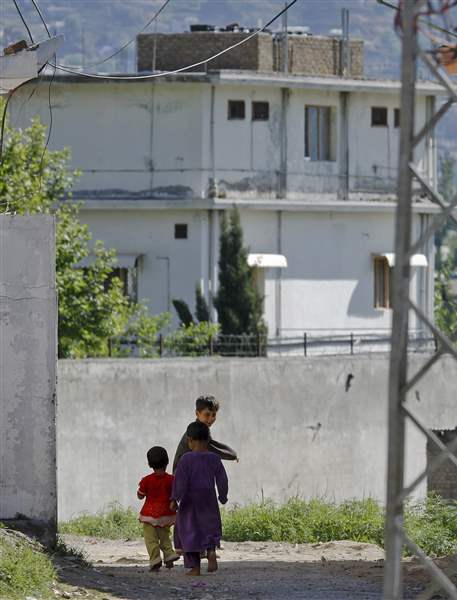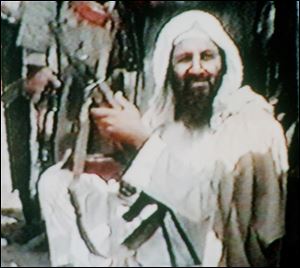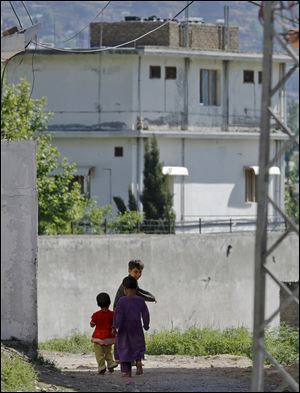
Officials: Bin Laden journal and letters show he eyed small cities, wanted a big body count
5/12/2011
Pakistani children earlier this week walk past the house of former al-Qaida leader Osama bin Laden in Abbottabad, Pakistan.
Anjum Naveed / AP

Osama bin Laden holds an AK47 automatic rifle in an image from an undated recruitment video tape for his organization, as viewed by The Associated Press in Kuwait City in 2001.
WASHINGTON — Though hunted and in hiding, Osama bin Laden remained the driving force behind every recent al-Qaida terror plot, U.S. officials say, citing his private journal and other documents recovered in last week's raid.
Until Navy SEALs killed him a week ago, bin Laden dispensed chilling advice to the leaders of al-Qaida groups from Yemen to London: Hit Los Angeles, not just New York, he wrote. Target trains as well as planes. If possible, strike on significant dates, such as the Fourth of July and the upcoming 10th anniversary of the attacks of Sept. 11, 2001.
Above all, he urged, kill more Americans in a single attack, to drive them from the Arab world.
Bin Laden's written words show that counterterrorist officials worldwide underestimated how key he remained to running the organization, shattering the conventional thinking that he had been reduced through isolation to being an inspirational figurehead, U.S. officials said Wednesday.
His personal, handwritten journal and his massive collection of computer files show he helped plan every recent major al-Qaida threat the U.S. is aware of, including plots in Europe last year that had travelers and embassies on high alert, two officials said. So far, no new plots have been uncovered in bin Laden's writings, but intelligence officials say it will take weeks, if not months, to go through them.
They described the intelligence to The Associated Press only on condition of anonymity because they were not authorized to talk publicly about what was found in bin Laden's hideout.

Pakistani children earlier this week walk past the house of former al-Qaida leader Osama bin Laden in Abbottabad, Pakistan.
The records show bin Laden was communicating from his walled compound in Pakistan with al-Qaida's offshoots, including the Yemen branch, which has emerged as the leading threat to the United States. U.S. officials have not shared any specific evidence yet that he was directly behind the attempted Christmas Day 2009 bombing of a Detroit-bound airliner or the nearly successful attack on cargo planes heading for Chicago and Philadelphia, but it's now clear that they bear some of bin Laden's hallmarks.
He was well aware of U.S. counterterrorist defenses and schooled his followers how to work around them, the messages to his followers show. Don't limit attacks to New York City, he said in his writings. Consider other areas such as Los Angeles or smaller cities. Spread out the targets.
In one particularly macabre bit of mathematics, bin Laden's writings show him musing over just how many Americans he must kill to force the U.S. to withdraw from the Arab world. He concludes that the smaller, scattered attacks since the 9/11 attacks had not been enough. He tells his disciples that only a body count of thousands, something on the scale of 9/11, would shift U.S. policy.
He also schemed about ways to sow political dissent in Washington and play political figures against one another, officials said.
The communications were in missives sent via plug-in computer storage devices called flash drives. The devices were ferried to bin Laden's compound by couriers, a process that is slow but exceptionally difficult to track.
Intelligence officials have not identified any new planned targets or plots in their initial analysis of the 100 or so flash drives and five computers that Navy SEALs hauled away. Last week, the FBI and Homeland Security Department warned law enforcement officials nationwide to be on alert for possible attacks against trains, though officials said there was no specific plot.
Officials have not yet seen any indication that bin Laden had the ability to coordinate timing of attacks across the various al-Qaida affiliates in Pakistan, Yemen, Algeria, Iraq and Somalia. It is also unclear from bin Laden's documents how much the affiliate groups followed his guidance. The Yemen group, for instance, has embraced the smaller-scale attacks that bin Laden's writings indicate he regarded as unsuccessful. The Yemen branch had already surpassed his central operation as al-Qaida's leading fundraising, propaganda and operational arm.
Al-Qaida has not named bin Laden's successor, but all indications point to his No. 2, Ayman al-Zawahri. The question is whether al-Zawahri, or anyone, has the ability to keep so many disparate groups under the al-Qaida banner. The groups in Somalia and Algeria, for instance, have very different goals focused on local grievances. Without bin Laden to serve as their shepherd, it's possible al-Qaida will further fragment.
British officials said the Americans had shared some information with them about the bin Laden cache, but they said they had been shown nothing concrete yet to indicate bin Laden's helped directly plan recent terror attacks or plans in Britain — including a European plot last year involving the threat of a Mumbai-style shooting spree in a capital. They spoke on condition of anonymity to discuss matters of intelligence.
One British official said counterterror authorities had not been tracking bin Laden like they had other terrorists deemed more directly involved in operations.
While Obama has ordered that photos of bin Laden's body be kept from public view, members of the House and Senate Intelligence and Armed Services committees have been making appointments at CIA headquarters to view the graphic images.
Sen. James Inhofe, R-Okla., a Senate Armed Services Committee member, said he spent nearly an hour Wednesday looking over more than a dozen photos taken at the Pakistan compound the night bin Laden was killed and on board the U.S. Navy ship that buried his body at sea.
One of the photos was of bin Laden's head and showed what appeared to be a fatal wound, according to Inhofe.
Some lawmakers had no interest in seeing the photos. Said Rep. John Garamendi, D-Calif., a member of House Armed Services Committee, "I'm quite satisfied Osama bin Laden is dead."